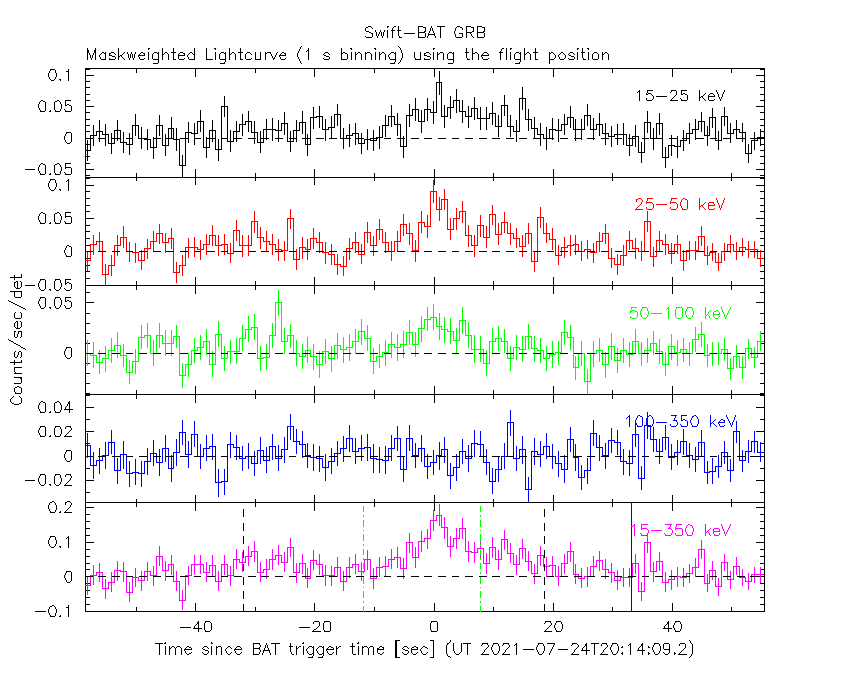
P. D'Avanzo (INAF-OAB), P.A. Evans (U. Leicester) and S.J. LaPorte (PSU) for the Swift team
At 20:14:09 UT, the Swift Burst Alert Telescope (BAT) triggered and located GRB 210724A (trigger=1061482) (D'Avanzo et al. GCN Circ. 30497). Swift slewed immediately to the burst. At the time of the trigger, the initial BAT position was 105° from the Sun (6.9 hours East) and 86° from the 99%-illuminated Moon. Table 1 contains the best reported positions from Swift, and the latest XRT position can be viewed at http://www.swift.ac.uk/xrt_positions.
de Ugarte Postigo et al. (GCN Circ. 30511) reported the position from GTC for the optical afterglow of this GRB. Table 2 is a summary of GCN Circulars about this GRB from observatories other than Swift.
Standard analysis products for this burst are available at https://gcn.gsfc.nasa.gov/swift_gnd_ana.html.
As reported by Laha et al. (GCN Circ. 30513),
the BAT ground-calculated position is RA, Dec = 227.425, -6.279 deg which is RA(J2000) = 1
The mask-weighted light curve (Figure 1) shows a multi-peaked structure that starts at ~T-40 s and ends at ~T+25 s.
The main peak occurs at ~
The time-averaged spectrum from T-38.55 to T+25.50 s is best fit by a simple power-law model.
The power law index of the time-averaged spectrum is 2.30 ± 0.28.
The fluence in the 15-150 keV band is 1.8 ± 0.2 x 1
The results of the batgrbproduct analysis are available at https://gcn.gsfc.nasa.gov/notices_s/1061482/BA/.
Analysis of the initial XRT data was reported by Evans et al. (GCN Circ. 30515). We have analysed 24 ks of XRT data for GRB 210724A, from 123 s to 509.7 ks after the BAT trigger. The data comprise 263 s in Windowed Timing (WT) mode with the remainder in Photon Counting (PC) mode.
The late-time light curve (Figure 2) (from T0+4.9 ks) can be modelled with a power-law decay with a decay index of α=0.85 ± 0.11.
A spectrum formed from the WT mode data can be fitted with an absorbed power-law with a photon spectral index of 2.48 ± 0.08. The best-fitting absorption column is 2.08 (+0.23, -0.22) x 1
A summary of the WT-mode spectrum is thus:
Total column: 2.08 (+0.23, -0.22) x 1
Galactic foreground: 8.2 x 1
Excess significance: 9.5 σ
Photon index: 2.48 ± 0.08
The results of the XRT team automatic analysis are available at http://www.swift.ac.uk/xrt_products/01061482.
The Swift/UVOT began settled observations of the field of GRB 210724A 125 s after the BAT trigger
(LaPorte and D'Avanzo GCN Circ. 30529).
No optical afterglow consistent with the XRT position is detected in the initial UVOT exposures.
Table 3 gives preliminary
magnitudes using the UVOT photometric system
(Breeveld et al. 2011, AIP Conf. Proc., 1358, 373).
No correction has been made for the expected extinction in the Milky Way
corresponding to a reddening of

Figure 1. The BAT
mask-weighted light curve in the four individual and total
energy bands. The units are counts

Figure 2. The XRT light curve.
Any data from a crosshatched region are not included in the fit.
| RA (J2000) | Dec (J2000) | Error | Note | Reference |
|---|---|---|---|---|
| 1 |
-06°17'26.5" | 3.0" | XRT-final | UKSSDC |
| 1 |
-06°17'26.5" | 3.0" | XRT | Evans and D'Avanzo GCN Circ. 30547 |
| 1 |
-06°16'42.9" | 1.9' | BAT-refined | Laha et al. GCN Circ. 30513 |
| Band | Authors | GCN Circ. | Subject | Observatory | Notes |
|---|---|---|---|---|---|
| Optical | Lipunov et al. | 30496 | Swift GRB210724.84: Global MASTER-Net observations report |
MASTER | |
| Optical | de Wet et al. | 30498 | MeerLICHT upper limits | MeerLICHT | upper limits |
| Optical | de Ugarte Postigo et al. | 30511 | Afterglow candidate from OSIRIS/GTC | GTC | detection |
| Optical | Belkin et al. | 30518 | Zeiss-1000 of Koshka observatory, optical upper limit |
Koshka Obs. | upper limits |
| Optical | Kann et al. | 30551 | Early CAHA 2.2m limit | CAHA | upper limits |
| Filter | Exp(s) | Mag | ||
|---|---|---|---|---|
| whit |
125 | 275 | 147 | >20.8 |
| 283 | 513 | 226 | >20.1 | |
| white | 125 | 275 | 147 | >20.8 |
| u | 283 | 513 | 227 | >20.1 |
Table 3. UVOT observations reported by LaPorte and D'Avanzo (GCN Circ. 30529). The start and stop times of the exposures are given in seconds since the BAT trigger. The preliminary 3-σ upper limits are given. No correction has been made for extinction in the Milky Way.
July 31, 2021